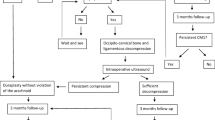Abstract
This study aims to introduce a new surgical procedure for the treatment of Arnold–Chiari type I malformation (ACM-1) and to compare its effectiveness with the techniques described in previous studies. We performed the following procedures: foramen magnum decompression combined with the removal of both the atlanto-occipital membrane, extended resection of the cerebellomedullary fissure arachnoid membrane, and artificial duraplasty to enlarge the membranic posterior fossa without resecting the cerebellar tonsils and syringosubarachnoid shunting. There were 21 ACM-1 patients: 12 cases had osteo-compression on the cerebellar hemisphere, 18 cases had thickened adhered fabric ring that stretched from arachnoid membrane to cerebellar hemisphere, and 15 cases with syringomyelia. The patients were followed up for 6 months to 3 years after the surgery. All patients showed a remarkable recovery of syringomyelia. There were no morbidity or death related to the surgery. Most of ACM-1 patients, the osteo- and membrane compression on cerebellar hemisphere and tonsil were observed during the operation. Therefore, decompression of foramen magnum and posterior craniocervical combined with the removal of cerebellomedullary fissure arachnoid membrane and placement of an artificial dural graft should be considered as a comprehensive option of minimally invasive surgery and rational and radical treatment of ACM-1. Our experience showed that, by using our procedure, shunting becomes no longer necessary in the treatment of ACM-1-associated syringomyelia.


Similar content being viewed by others
References
Tator, C. H., Meguro, K., & Rowed, D. W. (1982). Favorable results with syringosubarachnoid shunts for treatment of syringomyelia. Journal of Neurosurgery, 56, 517–523.
Krieger, M. D., McComb, J. G., & Levy, M. L. (1999). Toward a simpler surgical management of Chiari I malformation in a pediatric population. Pediatric Neurosurgery, 30, 113–121.
Goel, A., & Desai, K. (2000). Surgery for syringomyelia: An analysis based on 163 surgical cases. Acta Neurochirurgica, 142, 293–301.
Chou, Y. C., Sarkar, R., Osuagwu, F. C., & Lazareff, J. A. (2009). Suboccipital craniotomy in the surgical treatment of Chiari I malformation. Childs Nervous System, 25, 1111–1114.
Huang, P. P., & Constantini, S. (1994). “Acquired” Chiari I malformation. Case report. Journal of Neurosurgery, 80, 1099–1102.
Duddy, M. J., & Williams, B. (1991). Hindbrain migration after decompression for hindbrain hernia: a quantitative assessment using MRI. British Journal of Neurosurgery, 5, 141–152.
Saceda-Gutierrez, J. M., Isla-Guerrero, A., Alvarez-Ruiz, F., Odene-Cantero, C., Hernandez-Garcia, B., & Marquez Perez, T. M. (2011). [Postoperative complications in Chiari I malformation: Duroplasty and cerebrospinal fluid leak]. Neurocirugia (Astur)., 22, 36–42.
Todo, T., Usui, M., & Araki, F. (1993). Dandy-Walker syndrome forming a giant occipital meningocele—case report. Neurologia Medico-Chirurgica (Tokyo), 33, 845–850.
Batzdorf, U. (1988). Chiari I malformation with syringomyelia. Evaluation of surgical therapy by magnetic resonance imaging. Journal of Neurosurgery, 68, 726–730.
Hida, K., Iwasaki, Y., Koyanagi, I., Sawamura, Y., & Abe, H. (1995). Surgical indication and results of foramen magnum decompression versus syringosubarachnoid shunting for syringomyelia associated with Chiari I malformation. Neurosurgery, 37, 673–678.
Sindou, M., & Gimbert, E. (2009). Decompression for Chiari type I-malformation (with or without syringomyelia) by extreme lateral foramen magnum opening and expansile duraplasty with arachnoid preservation: comparison with other technical modalities (Literature review). Advances and Technical Standards in Neurosurgery, 34, 85–110.
Takigami, I., Miyamoto, K., Kodama, H., Hosoe, H., Tanimoto, S., & Shimizu, K. (2005). Foramen magnum decompression for the treatment of Arnold Chiari malformation type I with associated syringomyelia in an elderly patient. Spinal Cord, 43, 249–251.
Author information
Authors and Affiliations
Corresponding authors
Rights and permissions
About this article
Cite this article
Liang, C.J., Dong, Q.J., Xing, Y.H. et al. Posterior Fossa Decompression Combined with Resection of the Cerebellomedullary Fissure Membrane and Expansile Duraplasty: A Radical and Rational Surgical Treatment for Arnold–Chiari Type I Malformation. Cell Biochem Biophys 70, 1817–1821 (2014). https://doi.org/10.1007/s12013-014-0135-x
Published:
Issue Date:
DOI: https://doi.org/10.1007/s12013-014-0135-x




